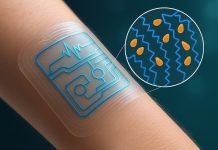
Imagine a portable 3D printer that fits in the palm of your hand. This tiny device could let you quickly create customized, low-cost objects wherever you are.
Need a fastener to fix a wobbly bicycle wheel?
Or a crucial component for a medical operation? This small gadget could make it possible.
Researchers from MIT and the University of Texas at Austin have made a big leap toward this vision.
They’ve demonstrated the first chip-based 3D printer. Their prototype device is a single, millimeter-sized photonic chip. It uses light beams to turn liquid resin into solid shapes.
This new kind of 3D printer doesn’t have any moving parts. Instead, it uses an array of tiny optical antennas to direct a light beam. The beam shines into a liquid resin, which hardens quickly when exposed to the light.
The interdisciplinary team combined silicon photonics and photochemistry to create a chip that can direct light beams to print two-dimensional patterns, like the letters “M-I-T.” The shapes form in just a few seconds.
Looking ahead, the researchers envision a system where the chip sits at the bottom of a well of resin and emits a 3D hologram of light. This would allow the entire object to harden in one step.
This portable 3D printer could have many uses. For example, doctors could create custom medical device parts on the spot. Engineers could quickly make prototypes at a work site.
“This system is rethinking what a 3D printer is. It’s no longer a big box sitting on a bench in a lab. It’s handheld and portable. It’s exciting to think about the new applications and how 3D printing could change,” says Jelena Notaros, a senior author of the study and a professor at MIT.
Other authors of the paper include Sabrina Corsetti, the lead author and a graduate student at MIT; Milica Notaros, who recently earned her Ph.D.; Tal Sneh, a graduate student; Alex Safford, a recent graduate from the University of Texas at Austin; and Zak Page, an assistant professor at UT Austin. Their research was published on June 6 in the journal “Light: Science & Applications.”
How It Works
Experts in silicon photonics, the Notaros group had previously developed systems that steer beams of light using tiny antennas on a chip. These systems are used in lidar sensors, which map surroundings by emitting infrared light that bounces off objects. The group then focused on systems that emit and direct visible light for augmented reality.
They wondered if a device like this could be used for a chip-based 3D printer. Around the same time, the Page Group at UT Austin showed that certain resins could be quickly hardened using visible light. This breakthrough was the missing piece for the chip-based 3D printer.
“With photocurable resins, it’s hard to get them to harden at infrared wavelengths. But here, we meet in the middle between photochemistry and silicon photonics, using visible-light-curable resins and visible-light-emitting chips,” Corsetti explains. “This merges two technologies into a new idea.”
Their prototype chip has an array of optical antennas that are just 160 nanometers thick (a sheet of paper is about 100,000 nanometers thick). The entire chip fits on a U.S. quarter.
When powered by an off-chip laser, the antennas emit a steerable light beam into the resin. The chip sits below a clear slide with a shallow indentation holding the resin. Electrical signals steer the light beam, causing the resin to harden wherever the beam hits.
This innovation could revolutionize how we think about and use 3D printing, making it more accessible, portable, and versatile than ever before.



